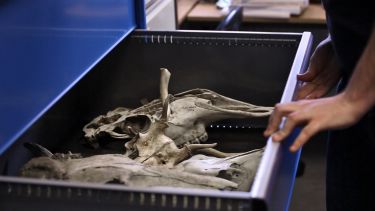Zooarchaeology Laboratory - Reference Collection
The Department of Archaeology has a long tradition of teaching and research in zooarchaeology. It also houses an important reference collection consisting of more than 2000 specimens. The collection is an integral part of the Department.

Contact
Email: zooarchlab@sheffield.ac.uk
Reference Collection Database
Both the research and teaching collections are focused on completeness and ease of use rather than display. The research collection includes complete and partial skeletons of modern animals, which are used as an aid to the identification of archaeological material, as well as for research purposes.
The collection includes a wide variety of specimens of mammals, birds, reptiles, amphibians and fishes that live or had once lived in Europe, as well as a more limited range of specimens from other parts of the world. About 30% of our more than 2000 specimens are sexed and aged, which helps with a more detailed identification of archaeological material and also provides the opportunity to use the collection as a research tool to address questions of morphological variability.
In addition, the availability of multiple specimens of individual taxa also provides the opportunity to use the collection for the establishment of identification criteria based on osteological material. Most skeletons kept in the collection derive from modern animals, but we also have some archaeological specimens, which can be very useful for comparative purposes, as many modern animals have been subject to such modifications in recent times that they have a limited resemblance with their ancient counterparts.
Special collections of mammal isolated teeth, mammal and bird postcranial bones, and fish bones have been organised by body part and kept in special cabinets. The bird index collection is organized by anatomical element, with each element divided into four size groups, each of them kept in a different cabinet. The bird collection, so arranged, is not only of great use for the identification of archaeological specimens but it also provides students with a prompt overview of the morphological variability in different bird orders and families. The fish index collection is arranged in a similar manner, only without size grouping but with colour-coding for families, to help in navigating the great taxonomical diversity of this group.
We make every possible effort to improve our collection and keep it in good order. New specimens are added whenever possible and we are also keen in setting up collaborations and possible exchanges with other laboratories that house animal bone collections.
A database of the collection is available to download. For each specimen, information about species, breed, provenance, age, sex and other details are included, whenever available.
Accessing the reference collection
The reference collection of the Zooarchaeology Laboratory of the University of Sheffield is located in the Ella Armitage Building and available for consultation and study through appointment, arranged with the staff of the Laboratory. The collection is used by many students and researchers, based in Sheffield or other institutions, both from the U.K. and abroad. It is also being regularly used by the current members of staff of the Zooarchaeology Laboratory to carry out research and consultancy work.
